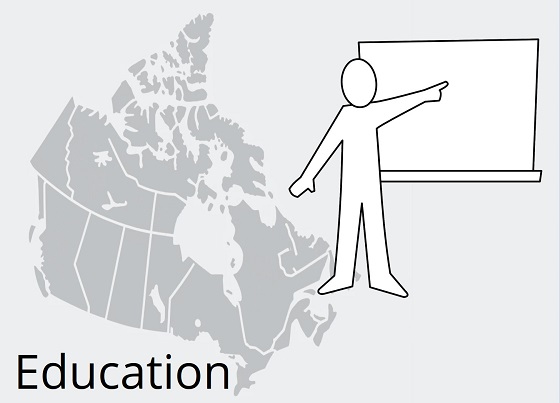Education
Rethinking Public Education

From The Audit
Holding public officials and institutions accountable using data-driven investigative journalism
What should public education accomplish?
On any given school day some six million Canadians between the ages of 5-18 are “locked up” – often against their will – inside K-12 schools. Approximately 2.5 percent of Canada’s gross domestic product is spent on public education. And, using Ontario as an example, that’ll cost more than $30 billion annually, or around 16 percent of the province’s budget.
Society invests heavily in education, and yet no one seems completely satisfied with the results. When was the last time you met an adult of any political stripe who didn’t have an opinion about what’s wrong with schools these days?
This piece was inspired by a comment to my recent Ranking Public Education Efficiency By Province post. That’s where I presented evidence suggesting increased funding would probably not solve the deep, systemic problems casting gloomy shadows up and down the halls of our ministries of education.
The Audit is a reader-supported publication. To receive new posts and support my work, consider becoming a free or paid subscriber.
So is there a better way to do public education? I honestly don’t know. But I do know that it’s unlikely we’ll ever find out if we don’t go back to the very beginning as ask some basic questions. And I also know that I haven’t seen most of these particular questions asked anywhere else:
What should public education accomplish?
How do you plan a trip if you don’t know where you want to go?
We can probably agree that all children should learn the skills they’ll need to live productive and successful lives as adults. And there’s not a lot of controversy in saying that those skills should include competence in reading, writing, and basic mathematics.
We can probably also agree that students should graduate with a healthy civic identity which would include comfort with, and loyalty to our cultural and legal heritage. However, things will get prickly when we try to define exactly what we mean by “identity” and “cultural”. Not to mention “heritage”. How do we decide whose definitions win?
Some will argue that schools should teach only skills and leave values out of the curriculum altogether. In other words, education should be culturally neutral. The biggest problem with that is that teachers aren’t neutral. Having taught high school for 20 years myself, I can tell you that, by design or by accident, a teacher enters the classroom as a complete and unsegmented person. And even the drowsiest, most distracted student senses it.
Some go a step further and advocate for teaching children the “critical thinking skills” they’ll need to make their own value judgments. Well that’s fine if you’re providing only the relevant epistemological, semantic, cognitive, and heuristic tools. But if your “critical thinking” curriculum includes even one values-based answer (see above for “unsegmented teachers”) then, by definition, you’re a propagandist.
What, exactly, is wrong with what we’ve already got?
There’s a lot here about which I simply don’t have enough clarity:
- I’ve read that grade inflation is allowing students to graduate without having mastered the content to which their transcripts attest. But I haven’t been able to find hard data to assess the claims.
- I’ve heard that employers are unsatisfied with the skills and work ethic of the young graduates applying for jobs. But how many employers? And how unsatisfied are they?
- As a (former?) IT system administrator, I’m well aware that large-scale technology adoptions in education environments were, historically, often the product of vendor hype, unreasonable expectations, and precious little serious research. And they often led to outrageous unintended consequences. But I’m no longer sufficiently plugged in to that world to have a sense of whether, on aggregate, technology is helping or harming children (or simply draining budgets).
- I’ve heard that at least some school boards appear to be dominated by extreme politically-driven ideologies. But how many boards are impacted? And how often do those ideologies find their way into classrooms?
- I’ve seen evidence that Ministry-level policy research is relying on poor and debunked scholarship. But has it made a difference with anyone involved with actual classroom teaching? (And how do you measure “debunked”?)
Should control over education policy be centralized?
Curriculum policy in Canada is generally set at the provincial ministry level and politely ignored everywhere else. I’ve already written about that in these pages. But, as discussed earlier, K-12 policy development costs us hundreds of millions of dollars each year across the country.
I’m not sure it’s even possible to impose detailed policy and curriculum guidelines. As a wise man once told me, you can tell them exactly what you want them to say but, with an arched eyebrow or a subtle voice inflection, experienced teachers communicate whatever message they want.
Now, considering how the system is currently funded, it makes perfect sense that elected officials at the provincial level should determine education policy. What makes somewhat less sense is that the policy researchers they hire appear to invest a great deal of energy resisting government “interference” and also refuse to share their research with the public who paid for it.
But, in theory at least, is the current system ideal?
Let me take a step back. What exactly is an education expert whose opinions qualify as authoritative? The issue is complicated by the many popular pedagogical theories that have come and (in some cases) gone over the decades. Those include constructivism, behaviorism, social learning theory, cognitive load theory, multiple intelligences theory, experiential learning theory, connectivism, situated learning theory, Bloom’s taxonomy, and humanistic education.
However I don’t believe that any single one of those – or even a combination – has ever achieved any kind of lasting consensus as they they cycle in and out of popularity. Nor can it be claimed that the policies set by whoever the credentialed experts happen to be have led to consistently satisfying results.
That is certainly not to suggest that the experts’ guidance hasn’t delivered successes over the years, or that they don’t bring value to the table. But, after more than a century’s worth of experiments with centralized educational control, it might be time to try something else.
Are all teenagers best served by mandatory enrollment?
When we acknowledge that no two children have identical needs and potential, it means that we have to be ready to treat them differently. And that’ll involve more than sending some kids to room 310 for their 10:30 class and others to room 315 across the hall. Isn’t it reasonable to wonder whether some teenagers can learn more and transition faster to responsible adult life outside educational frameworks?
Perhaps some truancy and child labour laws need updating.
Do vested interests stand in the way of positive change?
I honestly don’t know enough to have solid opinions on these questions, but they must be asked:
- Are teachers colleges politicized?
- Do the incentives driving powerful teachers unions conflict with students’ needs?
- Are sharply competing visions within ministries of education paralyzing the system (and wasting resources)?
- Should parent-advocates be allowed to interfere with educational professionals doing their work?
- Can every ministry job category still justify its costs – in both budget and institutional friction?
The inexorable inertia of incumbency is also a key player in this story.
What could replace the current model?
Some of the conflicts describe above come down to opposing worldviews. Are you a top-down governance type in whose eyes only “the authorities” have the knowledge and power to manage the lives of their subjects? Or do you see government as the servant of the people, existing only to fill in for the individual when faced with tasks requiring collective action? The worldview checkbox you tick will probably influence the kinds of alternatives you find yourself visualizing.
However, preconceptions shouldn’t be our only consideration. If there’s anything practical you could take away from this post, it’s that we need more serious research. Sure, I know there are good people out there thinking deeply about education policy. I’m far from the first person asking some of those questions.
But I haven’t yet come across any holistic discussion that starts from first principles and, in those terms, seeks to understand exactly what we’ve got and what we’re missing. And it’s only with that knowledge could we hope to build something genuinely new.
Happy 2024-2025 school year!
For a free subscription to The Audit. For the full experience, upgrade your subscription.
Alberta
Schools should go back to basics to mitigate effects of AI

From the Fraser Institute
Odds are, you can’t tell whether this sentence was written by AI. Schools across Canada face the same problem. And happily, some are finding simple solutions.
Manitoba’s Division Scolaire Franco-Manitobaine recently issued new guidelines for teachers, to only assign optional homework and reading in grades Kindergarten to six, and limit homework in grades seven to 12. The reason? The proliferation of generative artificial intelligence (AI) chatbots such as ChatGPT make it very difficult for teachers, juggling a heavy workload, to discern genuine student work from AI-generated text. In fact, according to Division superintendent Alain Laberge, “Most of the [after-school assignment] submissions, we find, are coming from AI, to be quite honest.”
This problem isn’t limited to Manitoba, of course.
Two provincial doors down, in Alberta, new data analysis revealed that high school report card grades are rising while scores on provincewide assessments are not—particularly since 2022, the year ChatGPT was released. Report cards account for take-home work, while standardized tests are written in person, in the presence of teaching staff.
Specifically, from 2016 to 2019, the average standardized test score in Alberta across a range of subjects was 64 while the report card grade was 73.3—or 9.3 percentage points higher). From 2022 and 2024, the gap increased to 12.5 percentage points. (Data for 2020 and 2021 are unavailable due to COVID school closures.)
In lieu of take-home work, the Division Scolaire Franco-Manitobaine recommends nightly reading for students, which is a great idea. Having students read nightly doesn’t cost schools a dime but it’s strongly associated with improving academic outcomes.
According to a Programme for International Student Assessment (PISA) analysis of 174,000 student scores across 32 countries, the connection between daily reading and literacy was “moderately strong and meaningful,” and reading engagement affects reading achievement more than the socioeconomic status, gender or family structure of students.
All of this points to an undeniable shift in education—that is, teachers are losing a once-valuable tool (homework) and shifting more work back into the classroom. And while new technologies will continue to change the education landscape in heretofore unknown ways, one time-tested winning strategy is to go back to basics.
And some of “the basics” have slipped rapidly away. Some college students in elite universities arrive on campus never having read an entire book. Many university professors bemoan the newfound inability of students to write essays or deconstruct basic story components. Canada’s average PISA scores—a test of 15-year-olds in math, reading and science—have plummeted. In math, student test scores have dropped 35 points—the PISA equivalent of nearly two years of lost learning—in the last two decades. In reading, students have fallen about one year behind while science scores dropped moderately.
The decline in Canadian student achievement predates the widespread access of generative AI, but AI complicates the problem. Again, the solution needn’t be costly or complicated. There’s a reason why many tech CEOs famously send their children to screen-free schools. If technology is too tempting, in or outside of class, students should write with a pencil and paper. If ChatGPT is too hard to detect (and we know it is, because even AI often can’t accurately detect AI), in-class essays and assignments make sense.
And crucially, standardized tests provide the most reliable equitable measure of student progress, and if properly monitored, they’re AI-proof. Yet standardized testing is on the wane in Canada, thanks to long-standing attacks from teacher unions and other opponents, and despite broad support from parents. Now more than ever, parents and educators require reliable data to access the ability of students. Standardized testing varies widely among the provinces, but parents in every province should demand a strong standardized testing regime.
AI may be here to stay and it may play a large role in the future of education. But if schools deprive students of the ability to read books, structure clear sentences, correspond organically with other humans and complete their own work, they will do students no favours. The best way to ensure kids are “future ready”—to borrow a phrase oft-used to justify seesawing educational tech trends—is to school them in the basics.
Business
Why Does Canada “Lead” the World in Funding Racist Indoctrination?
-

 International14 hours ago
International14 hours agoGeorgia county admits illegally certifying 315k ballots in 2020 presidential election
-

 Business2 days ago
Business2 days agoICYMI: Largest fraud in US history? Independent Journalist visits numerous daycare centres with no children, revealing massive scam
-

 Alberta1 day ago
Alberta1 day agoAlberta project would be “the biggest carbon capture and storage project in the world”
-

 Energy1 day ago
Energy1 day agoCanada’s debate on energy levelled up in 2025
-

 Business15 hours ago
Business15 hours agoWhat Do Loyalty Rewards Programs Cost Us?
-

 Haultain Research16 hours ago
Haultain Research16 hours agoSweden Fixed What Canada Won’t Even Name
-

 Business1 day ago
Business1 day agoSocialism vs. Capitalism
-

 Energy1 day ago
Energy1 day agoNew Poll Shows Ontarians See Oil & Gas as Key to Jobs, Economy, and Trade











